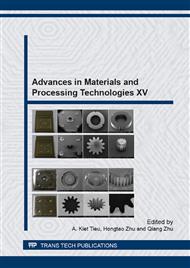p.818
p.827
p.833
p.842
p.851
p.865
p.880
p.887
p.894
Applications of Squeeze Casting for Automobile Parts
Abstract:
With an increasing pressure on automotive weight reduction, the demand on the lighter weight automotive components continues to increase. In recent years, squeeze casting processes have been used with different aluminium alloys to produce high integrity automotive parts. In this study, the indirect squeeze casting processes is adopted to cast a motorcycles component originally produced by a high pressure die casting process using aluminium alloy ADC12. To minimize amount of gas porosity inside squeeze casts, concepts of (1) minimization of ingate velocity along with (2) bottom filling pattern during the die filling, and (3) maximization of intensifications casting pressure are applied. Then parts are casted with both conventional high pressure die casting and indirect squeeze casting processes. Comparative evaluation of mechanical properties was made between HPDC casts and squeeze casts both in as-cast and heat treated conditions. Results from the experiment have shown that squeeze casts can pass the blister test at 490 °C for 2.5 hours. Then, squeeze casts are heat treated by solution treatment at 484 °C for 20 minutes and artificial age at 190 °C for 2.5 hours, respectively. This improves UTS of the heat treated squeeze cast to 254.14 MPa with 1.84% of elongation, while the UTS of as cast condition from both processes is not significantly different.
Info:
Periodical:
Pages:
887-893
Citation:
Online since:
November 2013
Price:
Сopyright:
© 2014 Trans Tech Publications Ltd. All Rights Reserved
Share:
Citation:


